Considering building an online pet marketplace to provide services and supplies? It's a great idea that can simplify pet owners’ lives. The figure for expenditure on pets in the U.S. reached more than $150 billion in 2024. So the need for innovative pet care services platforms that provide pet owners with top-quality, needs-based solutions is becoming more and more visible.
As more pets join families, the demand for easier ways to find products and services that meet their needs grows. In fact, studies have shown that what the pet owners community really cares about is convenience, quality and sustainability - so why not create a marketplace that gives them all of that in one place?
At Codica, we're passionate about turning our customer’s ideas into successful marketplaces. We will help you design a platform that is not only functional but also inspires loyalty and trust from your customers. Ready to take the leap and build something amazing? Let's dive into the strategies that will bring your vision to life and set your niche pet marketplace apart.
Understanding the online pet marketplace for services and supplies
A niche pet marketplace is a surefire way to bridge the gap between pet owners and the specific products and services they need.
General platforms have a broad view of the subject matter, but specialized digital pet services and supplies marketplaces like Pet Circle ensure that unique problems are met - breed-specific products, care for senior pets, and many more. Chewy, Petco and Rover are just a few of the other leading pet service providers that are addressing this need. These companies set a great example for new businesses looking to capitalize on this market by showing ways to align with consumer expectations.
Moreover, these specialized online pet marketplaces also tap into the growing trend of pet owners community-focused sites where pet caretakers are looking for much more than product availability: a source of trusted advice and professional services.
Here are the key shifts shaping their strategies and what they mean for the pet products ecommerce industry:
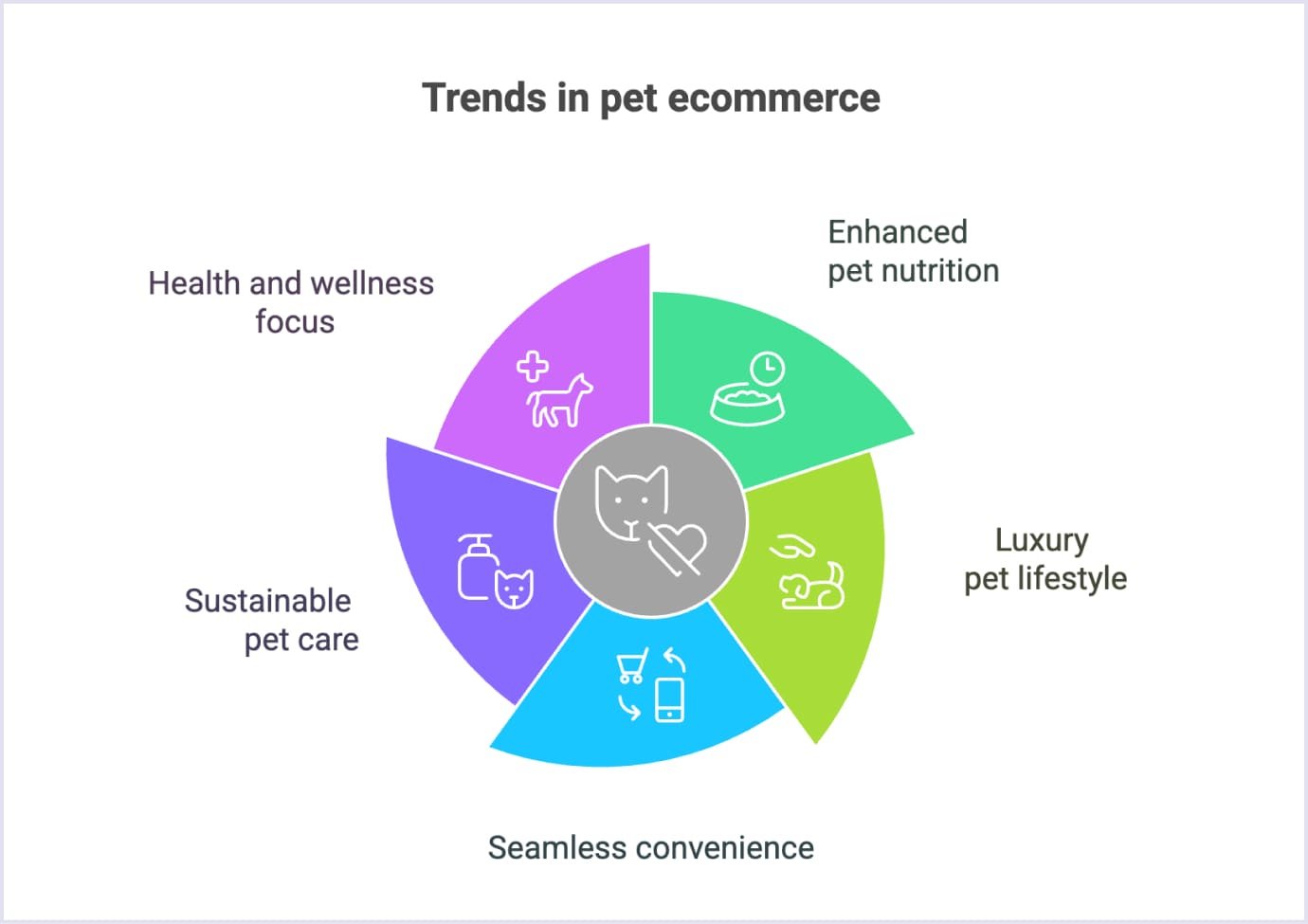
- Enhanced pet nutrition. Premium, organic, and breed-specific foods meet the dietary needs of pets and build trust with owners.
- Health and wellness focus. Supplements and fitness trackers help pets stay healthy, making these products highly sought after.
- Sustainable pet care. Eco-friendly items like biodegradable toys attract environmentally conscious pet owners.
- Luxury pet lifestyle. Luxury items like custom furniture cater to the growing humanization of pets.
- Seamless convenience. Omnichannel shopping offers seamless online and offline experiences for busy pet owners.
By investing in online marketplace development services, businesses can create platforms that are rich in features, offering personalized recommendations, subscription models, and advanced search functions, which greatly enhance value for pet owners and suppliers.
Read also: How Much Does It Cost to Build a Marketplace Website in 2025
Key features of a successful online pet marketplace for services and supplies
A successful online pet marketplace is built on features that directly improve the pet owner's community experience and ensure it's smooth and reliable.
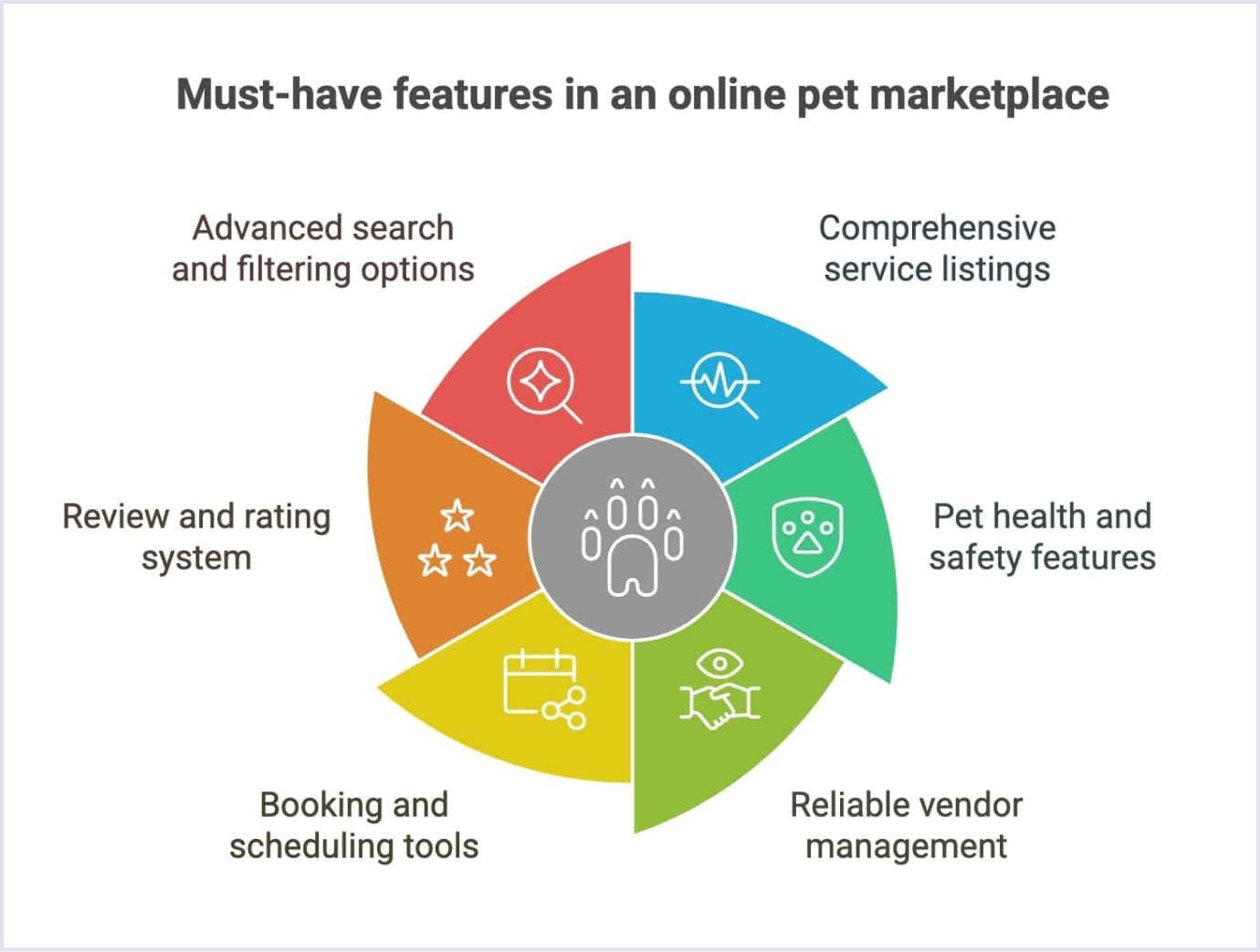
Easy navigation helps a user find what they need with ease, and complete service listings include descriptions, pricing and availability for greater trust and transparency. Advanced search and filtering features allow for quicker identification of products by pet type, dietary needs and location, ensuring less wasted time and more satisfaction.
In addition, integrated booking and scheduling tools facilitate in-service appointments such as grooming and training, while secure payment gateways ensure safe and seamless transactions.
For example, platforms like Chewy, Rover, Petco have gotten these factors right, setting the standard for usability and functionality in the pet marketplace. Now, let's look at each of these features and how they can help an online pet marketplace succeed.
User-friendly interface
An intuitive and attractive interface is a must for any online pet marketplace, allowing pet owners to easily navigate, search, and purchase products or book services. Platforms like Chewy do this exceptionally well by clearly categorizing pets, offering quick filtering options, and making checkout seamless. In their design, every function - shopping or navigation - feels seamless and intuitive.
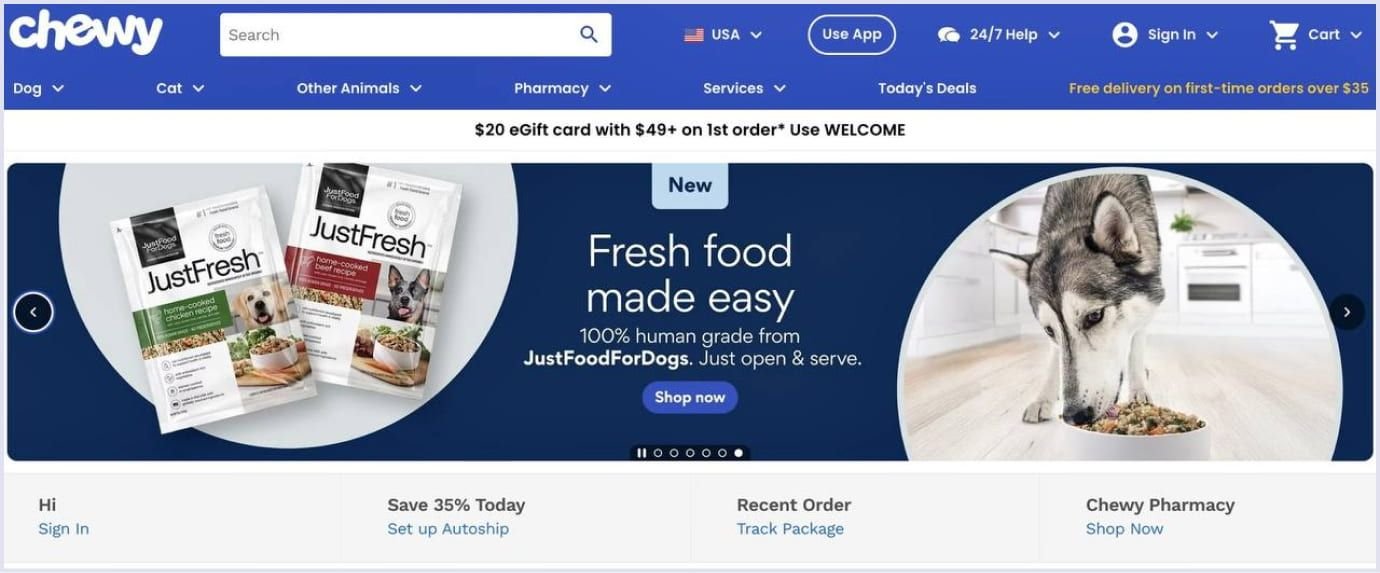
Source: Chewy
Chewy's interface not only provides accessibility to devices, but also incorporates features that enhance the shopping experience with a dedicated section for dogs, cats, and small pets. This intuitive layout has earned Chewy loyal customers by making browsing fun and hassle-free.
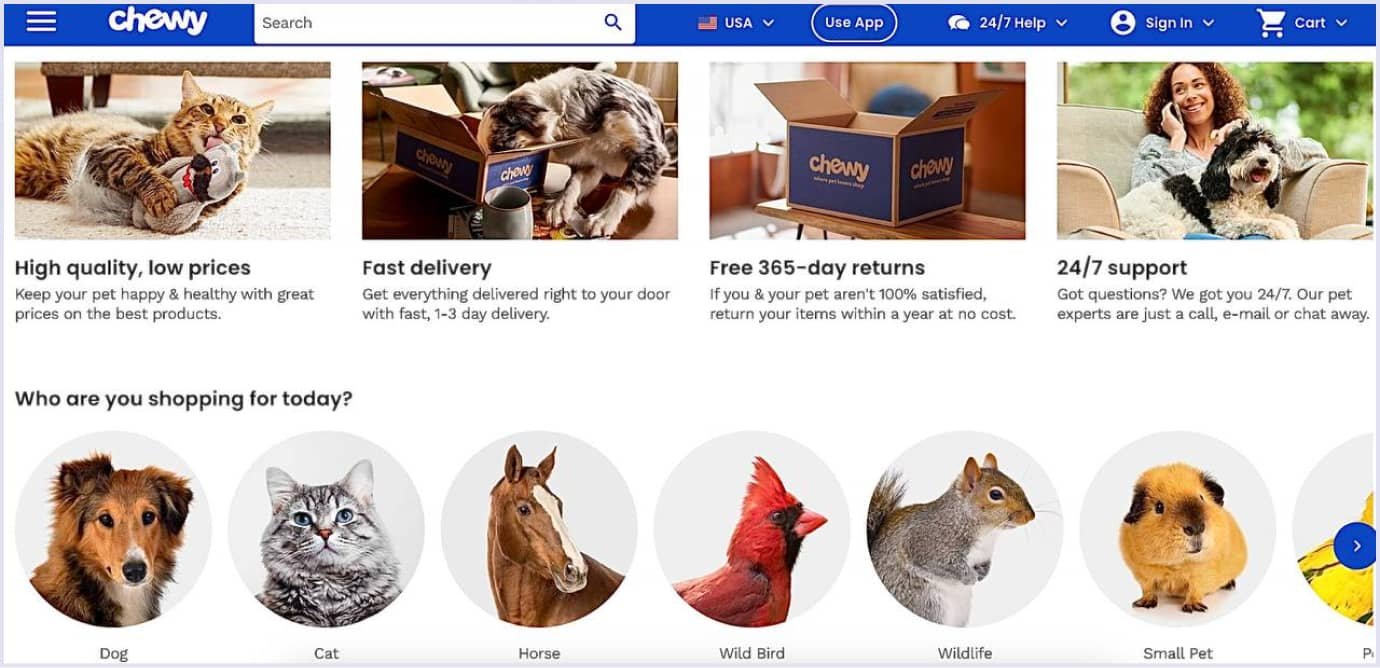
Source: Chewy
Pet health and safety features
Emphasizing pet health and safety can make a marketplace unique. Adding features such as vaccination reminders, health guides or emergency contact directories makes the platform more valuable. For example, Petco's Vital Care program combines health monitoring with subscription services to keep pets healthy.
Requiring vendors to meet safety standards for products and services also builds trust. Pet owners appreciate a marketplace that prioritizes their pets' well-being.
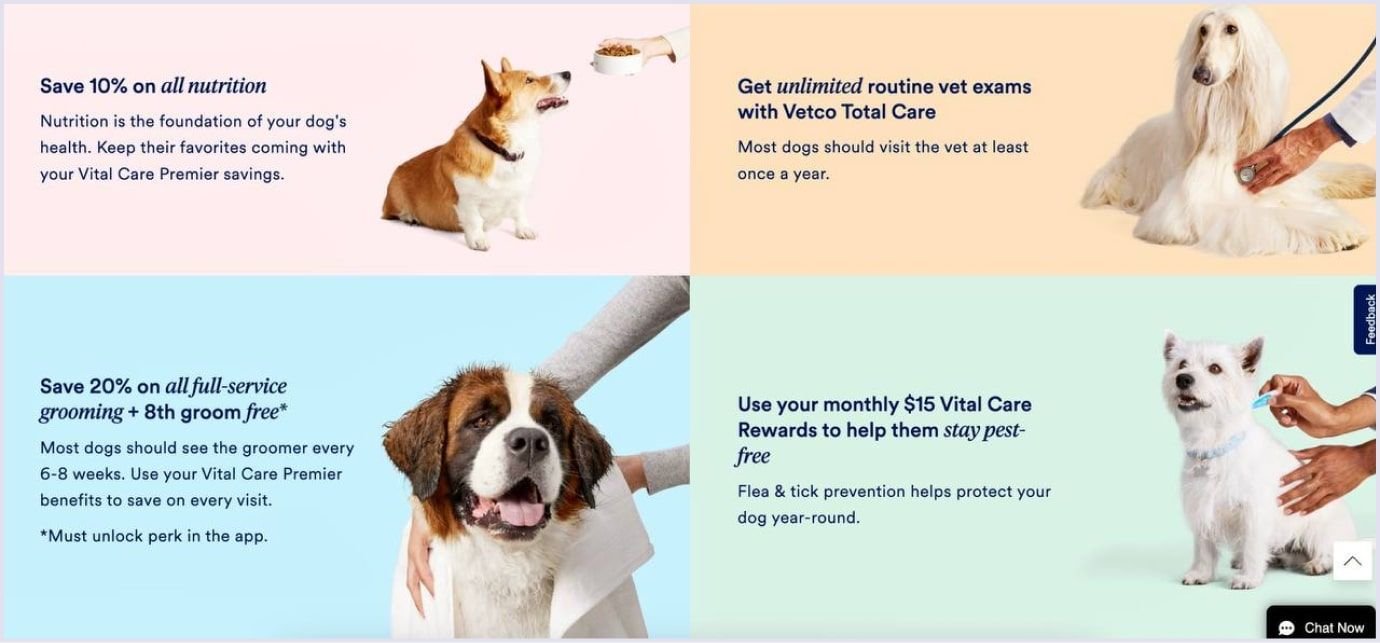
Source: Petco
Comprehensive service listings
Detailed listings give users confidence in their decisions. Descriptions, pricing, availability and reviews should all be clear on a listing. This is adequately addressed on Rover with profiles that show detailed experience, ratings and even certifications for each sitter.
Transparency in listings develops the element of trust between clients and service providers. This should be an essential feature in any online pet marketplace for credibility, attracting loyal customers, and many other reasons.
Reliable vendor management
Strong vendor management means strong quality for both the product and service. The strong system for onboarding and monitoring vendors, just like Amazon Pets, helps them keep standards high: vetting of sellers and regular tracking of performance.
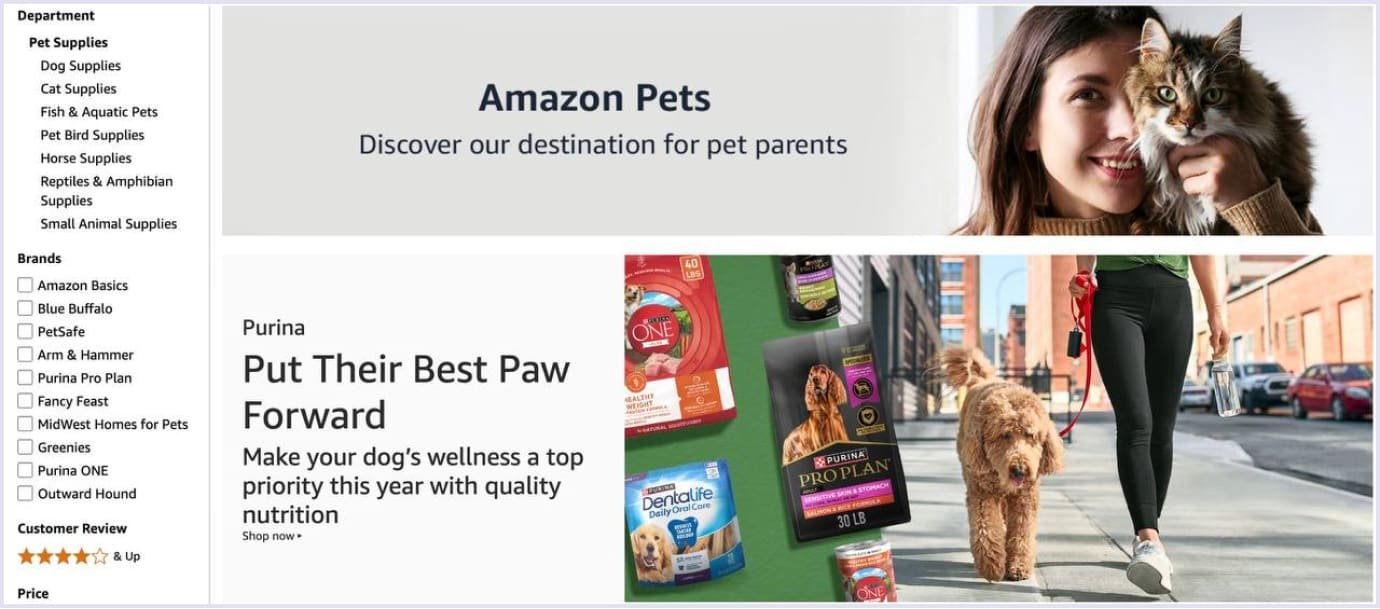
Source: Amazon
With reliable vendors, online pet marketplaces can offer a wide selection of quality items with minimal issues due to counterfeit or unsafe merchandise.
Booking and scheduling tools
It will make it easy for people to schedule the services their pets need, like grooming, training, or vet appointments. The schedule should show which slots are still open in real-time. Reminders or notifications should be sent automatically so people don't forget their appointment dates.
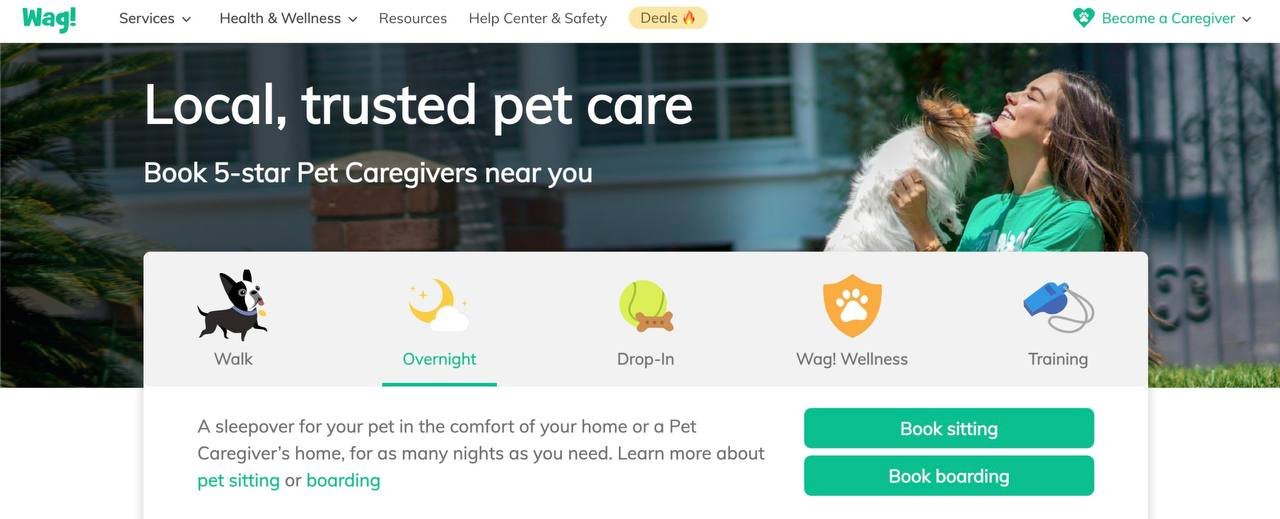
Source: Wag!
For example, Wag! has an easy-to-use app that makes booking dog walking, sitting, boarding, and training as easy as the click of a button. One can book either on-demand or schedule appointments, choosing from 20-, 30-, or 60-minute time slots. The app shows one the current available time slots, making it simple to book in a time convenient for the pet owner. In addition, the site offers other features, like GPS-tracked walks and automatic notifications, to keep the user updated and inform them of upcoming appointments.
Review and rating system
A transparent review and rating system helps build trust and maintains quality in the marketplace. That would let users leave feedback about the services provided, like pet sitting or training, or a product bought. Some platforms, like Rover, allow customers to rate pet sitters on their professionalism, punctuality, and quality of care to hold them accountable and competitive with other service providers.
The feedback loop, in an online pet marketplace, enables new users to make more detailed decisions while provoking the provider to consistently maintain a level of high-quality services. Reviews are important in building up a trustworthy and reliable platform.
Advanced search and filtering options
Advanced search capabilities are very important features that would help users find what they need faster and more efficiently. On the other hand, a platform like Chewy does an excellent job with filtering options regarding dietary preferences, product type, price range, brand, and even the size of the pet.
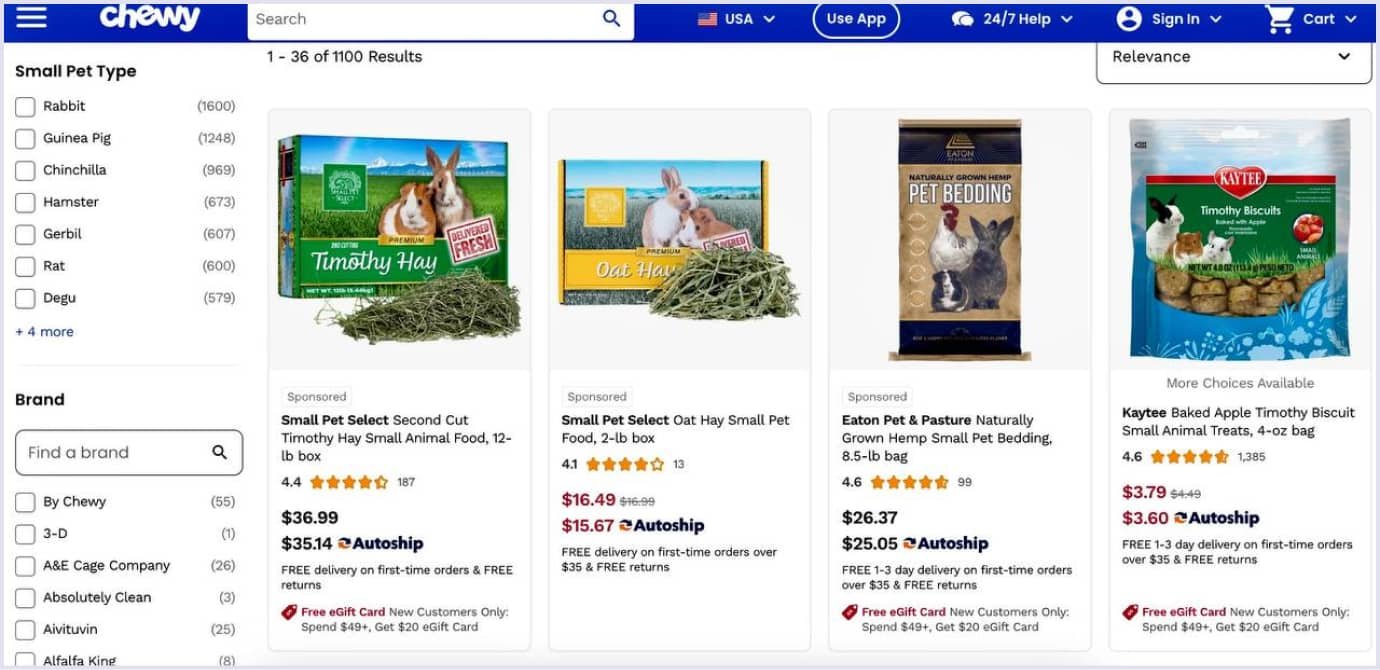
Source: Chewy
These save time and enhance the shopping experience, thus making these tools indispensable in a competitive online pet marketplace. If users can find what they are looking for with ease, it enhances their satisfaction and probability of returning.
Secure payment gateway
One of the main facets of building trust in any marketplace is having a safe payment system. Sites like Wag! offer multiple ways to pay, including credit cards and digital wallets, providing the most safety with encrypted transactions.
In an online pet marketplace, secure payment systems reduce cart abandonment, ensure a smooth checkout experience, and protect users from fraud. Providing flexibility in various payment methods caters to different customer preferences, thus making them more satisfied.
Customer support integration
Indeed, strong customer support is very important to build a really positive user experience. For that, Chewy has set the benchmark in the industry with 24/7 chat, email, and even phone support for prompt resolution of problems. They offer extensive knowledge base FAQ sections for self-help and even use chatbot options for immediate answers.
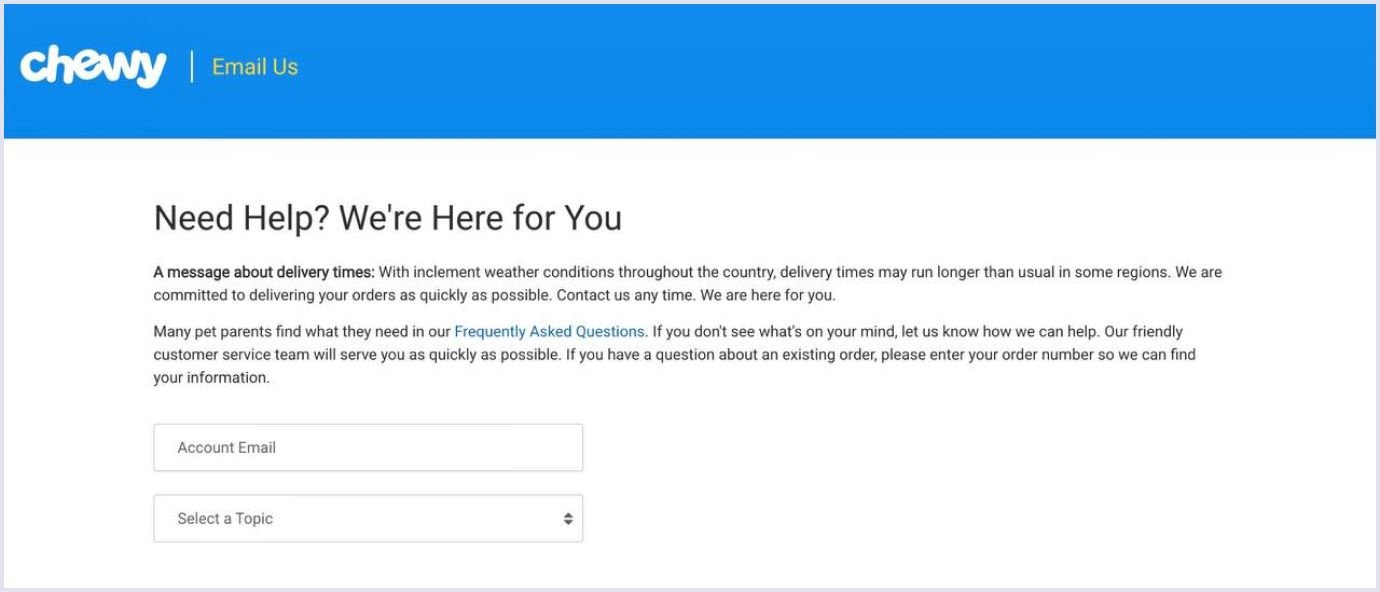
Source: Chewy
Incorporating accessible customer support into an online pet marketplace means taking care of customer satisfaction. Timely support earns trust and fosters repeated platform use for reliability and enjoyment.

Your 7-step guide to achieving excellence in pet marketplace development
Starting a successful online pet marketplace requires much more than just setting up the platform. Instead, it needs to build confidence in the space where pet owners get what they need. Below is a step-by-step guide that will walk through the main steps which would help build a great marketplace, ensuring real value for the users.
Step 1: Discovery session
A niche online pet marketplace only works if the very foundation is well-structured to ensure the platform meets the unique needs of pet owners and service providers. In this respect, the project discovery phase is important to identify gaps in the industry, define the must-have features, and shape the user experience of the platform.
Focus on the following key aspects during this phase:
- Market research. Studying the trends in pet services and supplies, competitor strategy moves. Also, identification of customer pain points.
- Feature prioritization. Clearly define which features will be core - supplier onboarding activities, booking capabilities, secure payment integrations.
- Goal setting. Establish specific, actionable goals regarding expected user growth, revenue streams, and vendors that would participate.
- Prototyping. Create prototypes to map user flows, ensuring an intuitive experience for both pet owners and service providers.
This is where product discovery services help a business validate its marketplace idea and avoid costly mistakes even before development kicks in.
Step 2: UI/UX design
Any niche online pet marketplace succeeds because of thoughtful, functional design at its core. Following the completion of clickable prototypes, a user experience blending practicality with visual appeal is produced. This would be where molding of the real platform into your special needs for pet owners and vendors is actually performed, as required to ensure an interaction that guarantees ease and fun.
Professional UI/UX design assures that your design avoids common web design mistakes, is both professional and really up to industry standards and customer expectations. Key UI/UX design priorities:
- Streamline user journeys. Make seamless processes for finding, booking, and purchasing smoother to save consumers' time through reduced friction in the user experience.
- Accessible design. Ensure your MVP includes font size adjustment, clear contrast, and a friendly layout to make the platform accessible to everyone.
- Emotional design.Use color, imagery, typography that would bring up a feeling of trust and anchor to the emotional bond one shares with his or her pet.
- Interactive feedback. Informs users where they are at any instance in time through animated feedback, progress indicators, and acknowledgment of actions taken.
Investing in UI/UX design services means that your pet care marketplace platform is going to provide exactly what the users are looking for and present them with a polished experience, making them stay with your brand. A well-designed online pet marketplace creates a long-lasting impression for more use and satisfaction.
Step 3: Choosing software architecture
The right software architecture will make or break your niche online pet marketplace.
MACH architecture vs. monolithic architecture
While monolithic settings seem easier, MACH architecture stands out hands down for performance, scalability, and future-proofing of your platform.
And here is why MACH is ideal:
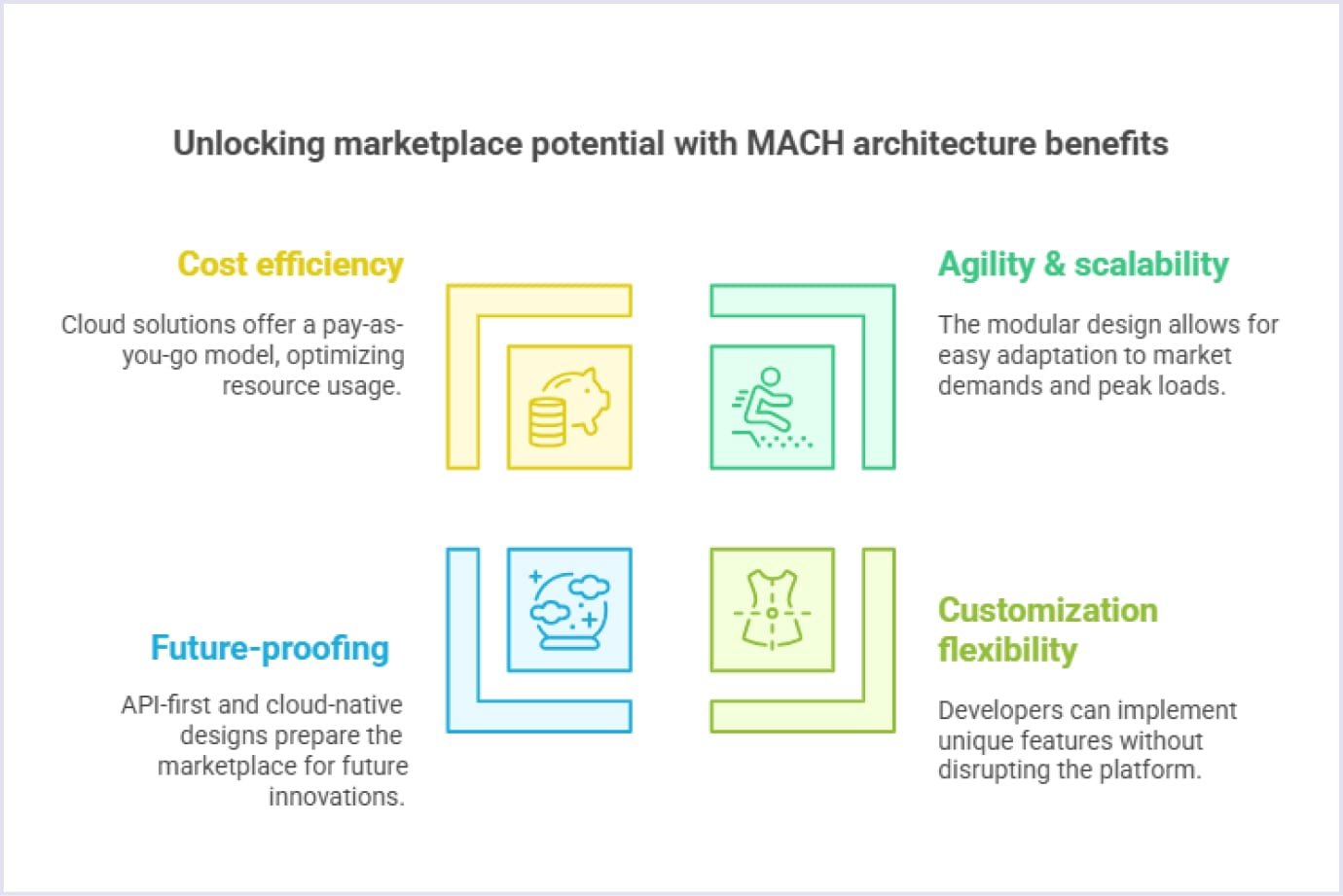
- Microservices. Every component-search, payments, booking - works independently to ensure scaling and performance are top-notch during high-traffic periods.
- API-first. Integrations with third-party tools like payment gateways, delivery systems, or AI-powered recommendations are easily achievable, making it flexible to new features.
- Cloud-native. Resources can be dynamically adjusted during sudden spikes - for instance, during a pet adoption drive or holiday shopping - with the benefit of cost-effective scalability and performance without interruption.
- Headless. Keep your platform visually competitive with flexible frontend updates, delivering a great experience across mobile and desktop without affecting backend systems.
With MACH, you’re building a marketplace that’s fast, scalable, and ready to adapt as your business grows. It’s the best choice for ensuring your platform performs smoothly while keeping up with evolving customer needs and industry trends.
Step 4: Technology stack selection
Every aspect of the technology stack plays its role in having the platform up and running and delivering a great user experience.
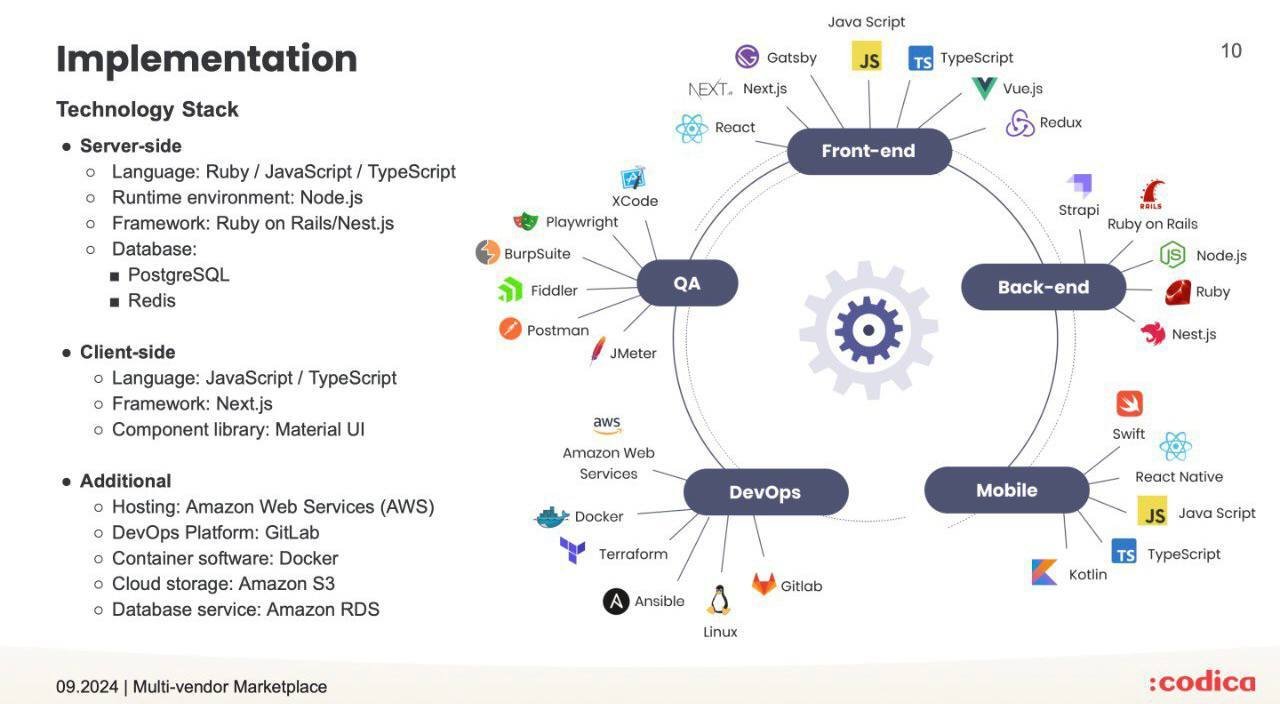
Well-thought-out choices here guarantee efficient development, long-term growth, and adaptability:
- Frontend.React, Vue.js, or Angular for dynamic and interactive interfaces.
- Backend.Node.js or Ruby on Rails for scalable and secure server-side processing.
- Databases. PostgreSQL, MySQL, or MongoDB for efficient data management.
- Cloud hosting.AWS, Google Cloud, or Azure for reliability, security, and scalability.
- Payment integration. Stripe, PayPal, or Square to facilitate smooth and secure transactions.
Step 5: Development
Development focuses on delivering a minimum viable product to get to market quickly, test a concept, and get valuable feedback that can help improve the product. By using MVP development services and focusing on core functionality first, you can save time and resources while laying the groundwork for further improvements:
- Feature prioritization. Pay greater attention to must-have features like user registration, product listing, search filters, and secure ways of paying for goods.
- Streamlined design. A clean and user-friendly interface design is required for smooth experiences.
- Efficiency and cost-effectiveness. Keep development costs as low as possible while making sure the core marketplace functions.
- Future improvements. Additional features such as advanced search, AI-based recommendations, and social integrations will be considered based on user insights.
In that respect, you adopt this iterative approach whereby you can launch the marketplace sooner, attract the first users, and then improve the platform for all real-life insights. This strategy ensures not only minimum risk but also a user-centric product development process.
Step 6: Testing
Quality assurance services form part of marketplace development, ensuring that the platform is reliable, secure, and free from technical glitches. Strong testing fixes problems before they go live so that users will have a seamless experience, thus keeping your marketplace reputation intact:
- Functional testing. It ensures that everything works as expected, right from user registration down to product listing, search filters, and payment processing.
- Performance testing. It is basically done to quantify the volume of traffic, load of transactions, and users acting simultaneously. The goal is that during busy periods - let's say, seasonal shopping or promotions - the marketplace should work well.
- Security testing. Find out the weak access controls or data encryption gaps that may lead to cyberattacks. Consequently, it will protect the sensitive information of users and prepare grounds for compliance with security regulations such as GDPR or PCI DSS.
- User experience testing. Assesses the platform’s navigation, design responsiveness, and overall usability. This ensures that users can browse, search, and complete transactions effortlessly, enhancing satisfaction and retention.
Thorough testing prevents costly post-launch fixes, boosts user trust, and positions the marketplace as a reliable and high-quality service.
Recommended reading: How Automation Testing Increases Execution Speed, Test Coverage, and Effectiveness
Step 7: Launching the marketplace
Marketplace going live is a fairly sensitive stage that requires a lot of preparation and a strategic execution plan to ensure that it happens at the right time, with maximum impact. This stage will include aspects such as actually deploying a platform, refining marketplace features, and scaling to meet growing demand:
- Beta testing. Soft launch to see the platform in actual use with minimal users to flag any remaining bugs.
- User feedback. Incorporate feedback from early adopters to tune features for better usability.
- Performance monitoring. Monitor key metrics, such as conversion rate, engagement, etc., that indicate how well the platform is performing.
A thoughtful launch strategy ensures that the marketplace starts strong and evolves to meet user expectations, setting the stage for long-term success. Opening an online pet marketplace for services and supplies is an exciting but challenging journey, which needs to be properly road-mapped. From research to UI/UX design, the selection of architecture, testing, and then launch, follow these crucial steps in order to build a top-notch niche pet marketplace platform.

Monetization strategies for your online pet marketplace
Making money from an online pet marketplace is important to make sure it's profitable and sustainable. A number of online pet marketplaces, such as Rover, Petco, and others, which are successful for services and supplies, normally combine these models.
This is important in making sure there are multiple ways to make money while serving the needs of both buyers and sellers.
Here are three popular ways to make money from an online pet marketplace, explained.
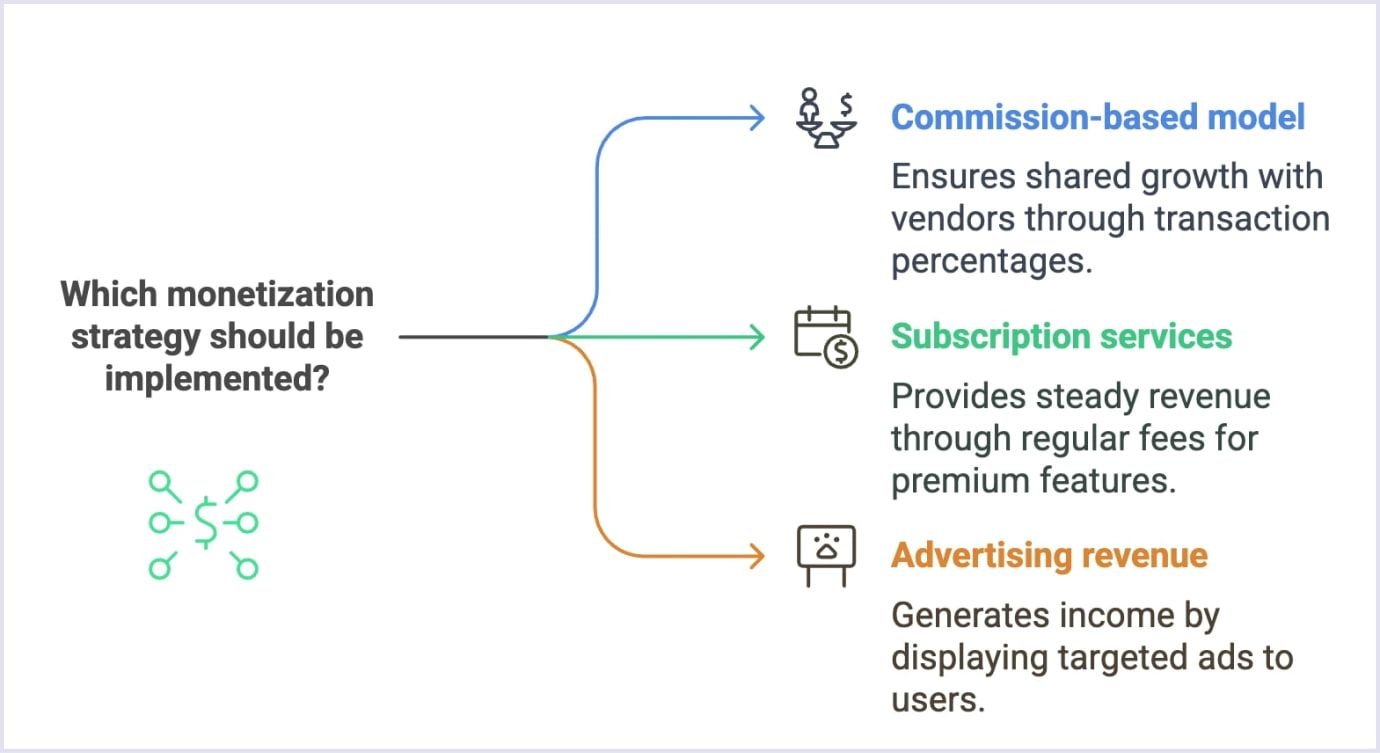
Commission-based model
In this model, an online pet marketplace gets a certain percentage of every transaction. This approach links the success of the platform to the activity of its vendors by guaranteeing shared growth:
- The onboarding of sellers is easy and without initial costs.
- The revenue will grow with sales and booking.
- Accommodates both products and services.
- Relatively easy for operators to manage the marketplace.
- Scales with the number of users.
Example: Rover charges a commission on every service booked, be that pet sitting or walking, thereby aligning incentives between the platform and the success of its vendors.
Subscription fees
Subscription fees are the charges from vendors or buyers for recurrent payment in order to use the platform or specific premium features. It offers predictable revenue and assures customer loyalty:
- Guarantees regular income for the marketplace.
- Serves best for regular users, like groomers or trainers.
- Can be complemented with premium visibility or discounts.
- Encourages long-term commitment.
- Applies to services meant for regular bookings.
Example: Petco's Vital Care program charges a monthly fee in exchange for health and wellness perks. It builds loyalty and provides recurring income.
Listing fees
Listing fees are paid by sellers for posting products or services. This model provides upfront revenue and ensures listings meet a certain standard:
- Generates revenue regardless of sales.
- Incentivizes vendors to create quality listings.
- Ideal for seasonal services or exclusive products.
- Flows well with other monetization models.
- Scales easily as more vendors join.
Example: Amazon Pets charges listing fees for third-party sellers. This guarantees only serious vendors post products for sale and ensures a steady stream of revenue.
Read also: 10 Best Monetization Practices for a Successful Online Marketplace in 2025
Ready to bring your marketplace idea to life?
An online marketplace for services and supplies is a perfect opportunity to help meet these developing needs and create a very successful and workable business model in this niche of pets. After researching, designing, and launching, following this orderly process could enable one to get such a unique platform for user retention. Applying monetization features, commission subscriptions and listing fees will surely contribute to the successful running of a business over a long period.
Here at Codica, we're all about taking great ideas and turning them into awesome web marketplaces. We've got you covered from top-notch designs to platforms that can grow with your business. Our team is with you every step of the way, making sure your journey to success is smooth and enjoyable. Would you like to learn more about how we work? Check out our case studies and contact us today to discuss your project. Let's build something amazing together!
